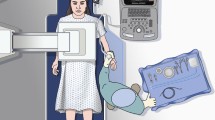Abstract
Aim
A clear understanding of operator experience is important in improving technical success whilst minimising patient risk undergoing endovascular procedures, and there is the need to ensure that trainees have the appropriate skills as primary operators. The aim of the study is to retrospectively analyse uterine artery embolisation (UAE) procedures performed by interventional radiology (IR) trainees at an IR training unit analysing fluoroscopy times and radiation dose as surrogate markers of technical skill.
Methods
Ten IR fellows were primary operator in 200 UAE procedures over a 5-year period. We compared fluoroscopy times, radiation dose and complications, after having them categorised according to three groups: Group 1, initial five, Group 2, >5 procedures and Group 3, penultimate five UAE procedures. We documented factors that may affect screening time (number of vials employed and use of microcatheters).
Results
Mean fluoroscopy time was 18.4 (±8.1), 17.3 (±9.0), 16.3 (±8.4) min in Groups 1, 2 and 3, respectively. There was no statistically significant difference between these groups (p > 0.05) with respect to fluoroscopy time or radiation dose. Analysis after correction for confounding factors showed no statistical significance (p > 0.05). All procedures were technically successful, and total complication rate was 4 %.
Conclusion
UAE was chosen as a highly standardised procedure followed by IR practitioners. Although there is a non-significant trend for shorter screening times with experience, technical success and safety were not compromised with appropriate Consultant supervision, which illustrates a safe construct for IR training. This is important and reassuring information for patients undergoing a procedure in a training unit.



Similar content being viewed by others
References
Ahmed K, Keeling AN, Khan RS et al (2010) What does competence entail in interventional radiology? Cardiovasc Interv Radiol 33(1):3–10
Epstein RM, Hundert EM (2002) Defining and assessing professional competence. JAMA 287(2):226–235
Gould DA (2007) Interventional radiology simulation: prepare for a virtual revolution in training. J Vasc Interv Radiol 18(4):483–490
Mendiratta-Lala M, Eisenberg RL, Steele JR, Boiselle PM, Kruskal JB (2011) Quality initiatives: measuring and managing the procedural competency of radiologists. Radiographics 31(5):1477–1488
Manyonda IT, Bratby M, Horst JS, Banu N, Gorti M, Belli AM (2012) Uterine artery embolization versus myomectomy: impact on quality of life-results of the FUME (fibroids of the uterus: myomectomy versus embolization) trial. Cardiovasc Interv Radiol 35(3):530–536
The REST Investigators (2007) Uterine-artery embolization versus surgery for symptomatic uterine fibroids. N Engl J Med 356:360–370
Hehenkamp WJ, Volkers NA, Birnie E, Reekers JA, Ankum WM (2008) Symptomatic uterine fibroids: treatment with uterine artery embolization or hysterectomy–results from the randomized clinical embolisation versus hysterectomy (EMMY) Trial. Radiology 246(3):823–832
http://www.bsir.org/Images/_Members/_Thomas_1303/File/uae_report_website.pdf. CIRSE 2006 Presentation. Owen AR Moss JG. Fluoroscopy times and Radiation Doses during Uterine Fibroid Embolisation—Lessons learnt from the UK Fibroid Registry
Stokes LS, Wallace MJ, Godwin RB, Kundu S, Cardella JF (2010) Society of interventional radiology standards of practice committee. Quality improvement guidelines for uterine artery embolization for symptomatic leiomyomas. J Vasc Interv Radiol 21(8):1153–1163
Looi JL, Cave A, El-Jack S (2011) Learning curve in transradial coronary angiography. Am J Cardiol 108(8):1092–1095
Ball WT, Sharieff W, Jolly SS, Hong T, Kutryk MJ, Graham JJ, Fam NP, Chisholm RJ, Cheema AN (2011) Characterization of operator learning curve for transradial coronary interventions. Circ Cardiovasc Interv 4(4):336–341
Räder SB, Jørgensen E, Bech B, Lönn L, Ringsted CV (2011) Use of performance curves in estimating number of procedures required to achieve proficiency in coronary angiography. Catheter Cardiovasc Interv 78(3):387–393
Conflict of interest
No authors have any conflict of interest or financial disclosures.
Statement of Informed Consent
Informed procedural consent was obtained from all individual participants included in the study. Due to retrospective study design, formal consent was not required.
Author information
Authors and Affiliations
Corresponding author
Rights and permissions
About this article
Cite this article
Das, R., Lucatelli, P., Wang, H. et al. Identifying the Learning Curve for Uterine Artery Embolisation in an Interventional Radiological Training Unit. Cardiovasc Intervent Radiol 38, 871–877 (2015). https://doi.org/10.1007/s00270-014-1040-9
Received:
Accepted:
Published:
Issue Date:
DOI: https://doi.org/10.1007/s00270-014-1040-9




